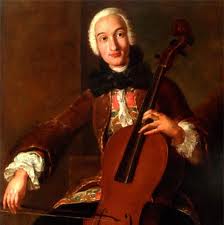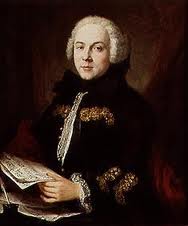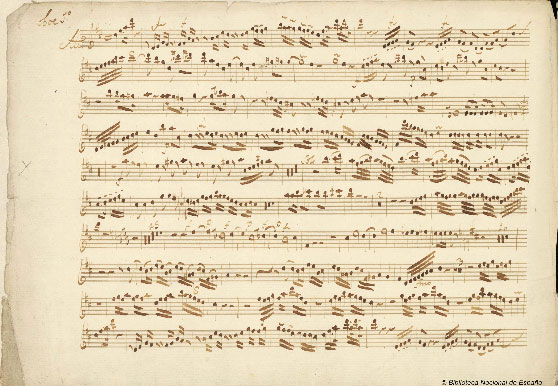The history of Boccherini’s quintets with guitar
By Yves GERARD, Professor at the Paris Conservatoire

To trace the history of Boccherini’s quintets with guitar is like a thriller on the one hand and like the intrigue comedy characteristic of the 18th century on the other hand. Even if we start with what we already know for certain: the thread of mystery will get through the facts. Luigi Boccherini comes from the town of Lucca where he was born on February 19, 1743 and developed his gift for the cello, taking the path most frequently followed by talented children at that time: the family circle – his father was a double-bass player; the religious education – the seminary in Lucca where the abbot Vanucci perfected his general and musical knowledge. His education was completed in Rome under violoncellist Costanzi who undoubtedly trained the fourteen years old boy in the traditions of the technique introduced and taught by the great violinist and pedagogue Tartini. Then he was faced with the alternative where to settle. Should he settle in Vienna where three successive contracts had brought the family in 1757, 1760 and 1763? Young Luigi became known as an instrumentalist-virtuoso and since the beginning of 1760, as a chamber music composer, writing two series of trios and quartets, with the latter consolidating the basic principles of the “modern” quartet in the already “classical’ dialectics of some movements.
Still the temporary contracts in Vienna did not bring stability to his life. Should he then settle in Lucca, his native place? This is what Boccherini had to decide between 1764 and 1767; the lack of more frequent opportunities of manifesting his talent dis- couraged him and he embarked on the nomadic life of a virtuoso. In 1765 he was in Milano with Sammartini who was then visited by a great number of composers: Gluck, Haydn and Mozart among many others. Boccherini himself also began regularly performing chamber works, together with Manfredi, Nardini and Cambini, probably the first permanent string quartet in the history of this instrumental formation. Then, between 1766 and 1767 Boccherini toured round North Italy, South Austria and finally France. Paris welcomed the virtuosi who performed at the “Concert Spirituel”. It was there that on March 20, 1768 Boccherini performed “as a maestro, one sonata of his own composition”, as the “Mercure de France” noted. Hesitation bothered the composer’s spirit again: should he stay in Paris, one of the European music-publishing centres, where his works would be regularly published up to his death? Or should he rather go to Madrid where, he was assured, the climate would have good effect on his delicate constitution and the royal patronage would guarantee the security of his occupations?
In 1768 Boccherini chose Spain but the beginning was full of risks. King Carlos III and his eldest son the Prince of Asturies did not know much about music. The monarch’s youngest brother, the infante Don Louis received Boccherini on November 8, 1770 and appointed him “a violoncellist at his court and composer of music”. Thus Boccherini settled in Madrid up to his death on May 28, 1805. The death of Don Louis (1785) faced the composer with the necessity of looking for new patrons: at one and the same time the powerful Spanish family of Duke de Benavente Osuna (rival of the d’Alba family and like it Maecenas and patron of all arts) and the Prussian monarch Friedrich-Wilhelm II claimed their patronage. The former appointed Boccherini a conductor of a 16-piece orchestra, giving concerts at the family luxurious palace in Puerta de la Vega; the latter supported him with a grant, provided he regularly sent his works in Berlin and Potsdam. This seeming balance was upset in 1798 when Friedrich-Wilhelm III refused to pay the grant given by his late father, and when the Benavente-Osuna family left on a mission to Vienna via Paris, where they finally settled. In spite of that Boccherini was lucky more or less.
The composer’s French publishers had been replaced by others who were still interested in his music and he continued to send manuscripts for publication in Paris. In a letter from December 24, 1798 Boccherini assured Pleyel that he had completed “three opuses, the third consisting of six quintets with obligatory guitar”. On June 20, 1799 he added: “My dear friends and sons (the musicians) Garat and Rode could listen at Marquis Benavente’s to almost the complete opus for piano (in my guitar transcription intended for him only). This is the first enigma: who was this Marquis de Benavente? Belonging to the family of Benavente-Osunas for more than two centuries, recently it became known that this was a wealthy amateur, apparently having nothing in common with his namesakes, who in the years 1798-99, and probably later, has played (by accident?) the role of Boccherini’s Maecenas. Other questions arise: are the works recorded in the present set and those heard by (Garat and Rode one and the same? The answer is no, as the collection of six quintets, even though almost entirely consisting of transcriptions of previous works for other chamber formations, does not restrict them to the performance of an ensemble of piano and strings only.
Therefore, the guitar quintets performed by Jean-Pierre Jumez and the Bulgarian Quartet included in the present release, are those mentioned in the letter from 1798. The only known manuscript mentions that they were “composed in Madrid for Mr. Marquis de Benavente”. Then other enigmas confronted the musicologists. Since the manuscript (held at the moment in the Washington Library of Congress) is not an autograph, should we not question the authenticity of these scores among Boccherini’s complete works? And who could have made this copy of the manuscript, dating from the beginning of the 19th century? Little by little all these questions found their answers. The six quintets are almost entirely transcriptions of works by Boccherini and there are no grounds for doubting the composer’s authorship. We would be right in insisting that the two added movements Minuetto from Quintet No. l and Allegretto from Quintet No. 2 have been written by Boccherini. As for the author of the copy now an American possession, a recent research by Mr. Matanya Ophee proved that this was Francois de Fossa, a military man, guitarist and composer. Could not the latter have modified the musician’s original text? The correspondence between Fossa and Boccherini’s first biographer Louis Piquot leaves one with the impression that what Fossa did was just copy the original.

The enigmas grow in number . . . and it is useless to present the reader-listener with such novels in instalments in which there alternate the unknown, the discovered, the confused and the sudden denouement: in a word all the barrages encountered in the labyrinth of a research. Let’s content ourselves with centring our remarks on three basic points. x x x To begin with, Boccherini has borrowed the essence of these six quintets from his own works, now concentrating on the arrangement of whole works (as is the case with quintet No. I (G.445), No. 2 (G. 446) and No. 3 (G.447) which simply reproduce the complete text of the three quintets with piano Op. 57, Nos. 4, 5 and 2 on which he must have worked at the same time, in keeping with his habit of composing at one and the same time and in succession two different opuses); now capturing fragments from previous works (Quintet No. 4 (G.448.), originating from two quintets for two cellos dating from 1771 and 1788, from which Boccherini has borrowed the most expressive and vivid parts, Pastorale and Fandango being two of them), or by borrowing here and there from some works for various formations(quintets No. 5 (G.449) and No. 6 (G.450) have been borrowed from a string quartet, the piano quintets Op. 56 and a flute quintet). The idea of completing this opus of six compositions as soon as possible must have justified these borrowings in Boccherini’s mind. Besides, we should point out the quality of these transcriptions.
Boccherini has so masterfully made use of the resources of the guitar, keeping the balance of the musical texture of the strings (two violins, viola and cello) that his ability to so skilfully reveal the technical capacities of this instrument is astonishing. Yet it seems that there is nothing surprising about this ability. Boccherini has written equally well for strings and piano, flute, oboe, two violas, making full use of the technical and expressive powers of these instruments. For an Italian musician living in Spain the guitar was not a totally unknown “exotic” instrument. Little is known today about the relations between Italian and Spanish music of that time. The Italian music “imported” in Spain was too conspicuously “aristocratic” in character, being intended for the noble and educated classes, in drastic contrast with the local folk music. And the more research is done on these two levels, the more evident the relation between them becomes. This would mean to forget, for example, the cultural exchange between the Spanish kingdom and the province of Naples, which has been thought as an Italian possession ever since but actually belonged to the Spanish crown and to that of the Bourbons, in particular. It can be supposed that Boccherini discovered the characteristics of the Spanish folk music on settling in Madrid. His works are not lacking in dance rhythms (fandango, seguidilla, tiranna) or in local musical modes (Andalusian scales) from Spain. A number of Boccherini’s works derive their peculiar sound from these most frequently used elements in keeping with the “classical ideal”, thus enriching the classical model of form and style by borrowings from certain folk songs. The imitation of musical moments from people’s everyday life, as well as of the musicians, playing in the streets of old Madrid, are present not only in the impressive Musica Notturna delle Strade di Madrid from 1780. And indeed, the characteristics of the guitar, both as an instrument and as manner of performance, are evident in the compositions for strings – for three, four or five parts, developed according to the number of instruments, hence rising to a “noble” level what would seem a “replica” of the “popular”. This is done so perfectly well that Boccherini’s style remains “intact” both in the series of six quintets and in some 500 other works completed and performed between 1760 and 1804. After all, the survey of these six compositions proves it.
The quintet musical analysis

The first quintet in D minor, one of the most, if not the most exciting from the series demonstrates with ease the characteristics of Boccherini’s style. In the manner typical of him the opening Allegro moderato teems with thematic ideas which relate one element, seemingly dispersed and gradually taking shape, to another idea, expressing grandeur. In the development (based on the already introduced elements) there springs up a new musical fragment, resembling a “nocturne”, preceding the reprise. It is in contrast with the beginning of the quintet, winding up with a repetition of the “majestic” element. The Cantabile reflects the composer’s nostalgic spirit both in the character of the accompanying melody which opens the movement and in the mysterious dialogue between the pizzicato of the strings and the descending scales of the solo guitar. Thus the composer seems to make the spirit of the listener roam idly in an opposition of the clearly expressed fragments in which all the instruments unite. The Minuetto is an illustration of the composer’s desire to make use of the traditional rhythm and tempo (the exposition of the menuet is divided into two repeated fragments; the trio is also divided into two fragments; followed by a repetition of the menuet without reprise), in order to insert in it stylistic inventions not having much in common with the character of the dance. Certainly, the main element is strikingly reminiscent of a dance “Tiranna” included in a string quartet from 1792, yet in the second part of the menuet the accent on the weak third beat in the measure and the “professional” expression of the Trio (an imitation of a modulating harmonic march) seem to reflect the aimed at compromise between “popular” and “professional” music in the simple, light tempo inspired by the tempo. The energetic and powerful beginning of the Finale resembles the enthusiasm and ardour present in young Rossini’s Sonata a quattro. We should note that at the end of the Quartet the “majestic” element from the beginning of the first movement is brought back, thus shaping the composition as a “closed” structure: an innovation recurrent in Boccherini’s previous works. All these notes are referable to the quintets that follow.
Let us restrict ourselves by pointing out in the Maestoso assai, opening Quintet No.2 in E major, the distinct opposition of thematic ideas, the unusual effect created by the unison of the five instruments, written in pianissimo in order to link two ideas and the extraordinary virtuosity of the first violin. Movement two consists of a solemn Adagio, in which there sounds a “quasi-romance”, as well as of an Allegretto, a lively and bright saltarella. The final Folaca is in the form of a broadly developed menuet with sudden modulations; in the Trio we shall notice this typically Boccherinian effect of temporary suspense preceding the “explosion” of an already heard element.
The Allegro moderato from Quintet No. 3 in B flat major opposes the theme of idleness from the beginning to a more rhythmically structured element; the Tempo di Minuetto is enriched by a Trio with fascinating modulations; the Adagio in which the guitar is omnipresent, includes in the modulating system of the “classical Vienna style” chords in the “Spanish manner”; the final Allegro, in which all the instruments are equally treated (with the solo guitar reexposing the initial theme), suggests the meaningfulness of silence: this will not be the only example of employment of this technique in the musician’s work.
Quintet No. 4 is the most expressive in the way it unites one Pastorale, characteristic of Boccherini’s “exquisite” style and a Grave and Fandango typical of the Spanish “Vitality”. The second movement, Allegro maestoso, is like a genuine part of a cello concerto (developed in the high register). The Fifth quintet in D major has two uniting centres: the theme of movement four, being a prologue to eight variations bearing features of both Italian and Spanish music (clearly marked in the eight variation) is nothing but the initial theme from the first movement Andantino pausatto. The light and syncopated theme abounding in the third movement, winds up the series of variations by a brief unexpected repetition. As for the Menuetto Allegro, it appears to anticipate Schubert’s style. Finally, Quintet No.6 in G major demonstrates Boccherini’s mastery of joining fragments which might seem disparate at first glance: such is the first part of Allegro con vivacita, which is actually split by the second; the third movement Tempo di Minuetto (whose theme is “severely” exposed in keeping with the canon) makes a fine link between the finale of the menuet and the beginning of the Trio by means of a triad, an expressive device characteristic of the Spanish music. The second movement. The second movement, Andantino lento, is reminiscent of a melancholic “waltz-serenade”; with a brief lively finale like a Spanish dance, the Allegretto completes this series of quintets.
These are popular works, one would say, claiming no seriousness. We could argue about this… Anyway, they reveal such relations common for Boccherini’s works, between the technical difficulties (they have to be performed by virtuosos) and the clear organization of the instrumental texture; between the Italian art and the Spanish spirit, between the borrowings of melodic and rhythmical elements of local origin and the zeal with which they have been united in a “classical style”. Are they classical works ? Undoubtedly they are. Still these pages breathing easiness and charm are full of tenderness and emotions which penetrate deep in the mind and the heart: is this not a form of Romanticism ? September 1983
Yves GERARD, Professor at the Paris Conservatoire
BIBLIOGRAPHY:
Luigi Boccherini Sei quintetti con chitarra. A critic edition by Yves Gérard (Paris, Heugel, collection Le Pupitre 29, score (1974), separate parts (1975)
The present recording has been made after this edition
Yves Gérard: Catalogue of the works of Luigi Boccherini (London, Oxford Un. Press, 1969)
Louis Picquot: Notice sur la vie et les ouvrages de Luigi Boccherini (Paris, Philipp, 1851 ; second edition in 1930 with Notes et Documents nouveaux by Georges de Saint-Foix)
Germaine de Rothschild: Luigi Boccherini. His life and work (London, Oxford Un. Press, 1965)
Matanya Ophee: Luigi Boccherini’s guitar quintets. New evidence (Boston Orphée, 1981) A study of the musicological problems arising from Boccherini’s guitar compositions






Dear Nacho Bellido,
Read your blog with interest and am wondering if the Boccherini quintets (especially the 1790s Fandango quintet) that include guitar would have been played on a five course instrument? Certainly in Boccherini’s time, at least in the first half of his life, the five course guitar would have been the most common guitar available. I’d be grateful for any info you had on this matter.
Many thanks
Chris (Challen)